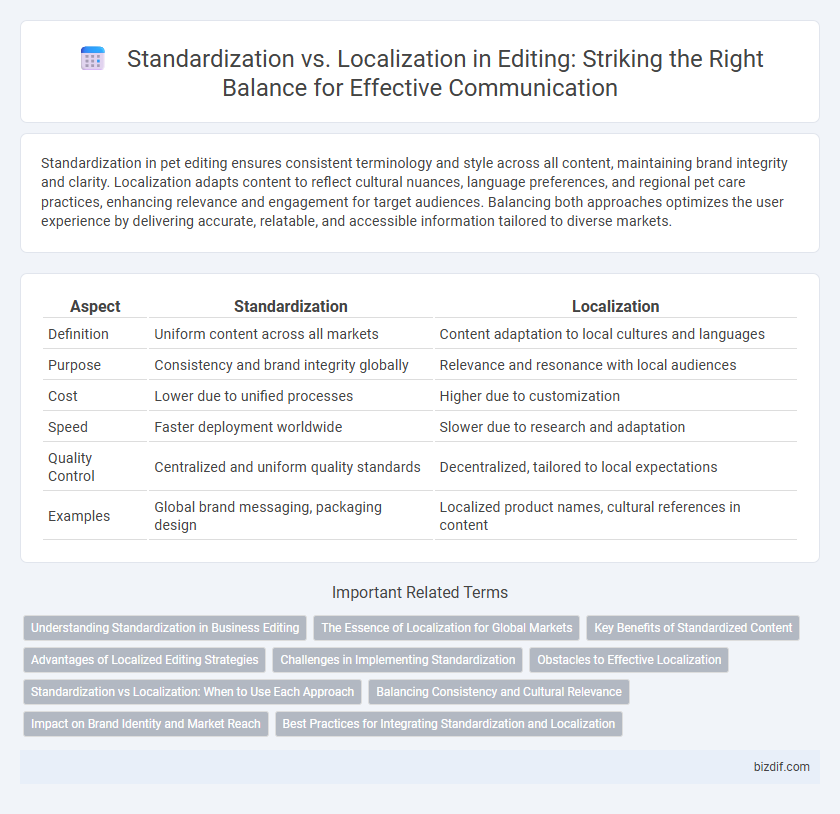Standardization in pet editing ensures consistent terminology and style across all content, maintaining brand integrity and clarity. Localization adapts content to reflect cultural nuances, language preferences, and regional pet care practices, enhancing relevance and engagement for target audiences. Balancing both approaches optimizes the user experience by delivering accurate, relatable, and accessible information tailored to diverse markets.
Table of Comparison
| Aspect | Standardization | Localization |
|---|---|---|
| Definition | Uniform content across all markets | Content adaptation to local cultures and languages |
| Purpose | Consistency and brand integrity globally | Relevance and resonance with local audiences |
| Cost | Lower due to unified processes | Higher due to customization |
| Speed | Faster deployment worldwide | Slower due to research and adaptation |
| Quality Control | Centralized and uniform quality standards | Decentralized, tailored to local expectations |
| Examples | Global brand messaging, packaging design | Localized product names, cultural references in content |
Understanding Standardization in Business Editing
Standardization in business editing involves creating uniform content that adheres to consistent style, terminology, and formatting guidelines across all documents, enhancing brand coherence and reducing errors. It streamlines the editing process by establishing clear editorial standards, ensuring efficiency and quality control within global business communications. Emphasizing standardization supports scalability and aligns content with corporate identity, making it essential for multinational organizations.
The Essence of Localization for Global Markets
Localization transcends standardization by adapting content to cultural nuances, language idioms, and regional preferences, ensuring relevance and resonance in global markets. It enhances user experience by tailoring marketing messages, legal compliance, and product information to local expectations, driving engagement and customer loyalty. This strategic customization is essential for businesses aiming to expand internationally while respecting diverse cultural identities.
Key Benefits of Standardized Content
Standardized content ensures consistent messaging and brand identity across multiple platforms and regions, enhancing audience recognition and trust. It reduces translation and production costs by streamlining workflows and minimizing redundancies. Maintaining uniform terminology and style guidelines improves content quality and accelerates time-to-market for global campaigns.
Advantages of Localized Editing Strategies
Localized editing strategies enhance cultural relevance and audience engagement by tailoring content to specific linguistic nuances and regional preferences. By adapting idiomatic expressions, cultural references, and formatting conventions, localized editing improves clarity and reader comprehension. These tailored approaches also boost market penetration and brand loyalty in diverse global regions.
Challenges in Implementing Standardization
Implementing standardization in editing faces challenges such as maintaining consistency across diverse languages and cultural nuances, which can lead to loss of meaning or tone. Editors must balance uniform style guides with local preferences, requiring extensive linguistic expertise and adaptive workflows. The complexity of integrating standardized tools with region-specific content increases time and resource demands, complicating project management.
Obstacles to Effective Localization
Obstacles to effective localization in editing include linguistic nuances, cultural differences, and technical constraints that challenge maintaining content accuracy and relevance. Inconsistencies in terminology standardization and inadequate adaptation of context-specific elements often result in loss of meaning or user engagement. Overcoming these barriers requires precise glossary management, cultural consultancy, and advanced localization tools to ensure quality and consistency across diverse markets.
Standardization vs Localization: When to Use Each Approach
Standardization in editing ensures consistency by applying uniform language, style, and terminology across all content, making it ideal for global brands seeking a cohesive message. Localization tailors content to specific cultural, linguistic, and market nuances, enhancing relevance and engagement for targeted audiences. Choose standardization for broad reach and brand unity, while localization suits diverse markets requiring cultural sensitivity and precise communication.
Balancing Consistency and Cultural Relevance
Balancing consistency and cultural relevance in editing requires harmonizing standardized language with localized nuances to ensure clarity and engagement across diverse audiences. Employing standardized style guides maintains uniformity in terminology and formatting, while incorporating regional expressions and cultural references enhances relatability and resonance. This equilibrium optimizes content accuracy and audience connection, facilitating effective communication in global and multicultural contexts.
Impact on Brand Identity and Market Reach
Standardization in editing ensures consistent brand identity by maintaining uniform language, tone, and style across all markets, reinforcing brand recognition and trust globally. Localization adapts content to cultural nuances, idiomatic expressions, and regional preferences, enhancing market reach by increasing relevance and engagement with diverse audiences. Balancing standardization and localization enables brands to preserve core identity while expanding market presence effectively.
Best Practices for Integrating Standardization and Localization
Effective integration of standardization and localization in editing requires establishing clear style guides that balance consistent terminology with culturally relevant adaptations. Leveraging translation memory tools and glossaries ensures uniformity while allowing tailored content to resonate with local audiences. Collaborative workflows between global and regional teams optimize quality and efficiency by combining centralized standards with localized insights.
Standardization vs Localization Infographic

 bizdif.com
bizdif.com